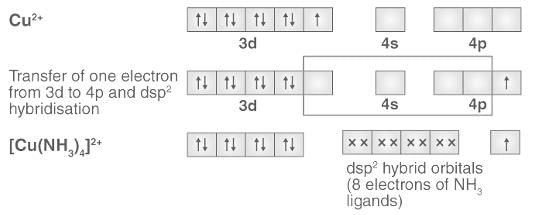Chemistry Exam > Chemistry Questions > Cuprammonium ion has ___________ shape.a)Octa...
Start Learning for Free
Cuprammonium ion has ___________ shape.
- a)Octahedral
- b)Tetrahedral
- c)Trigonal
- d)Square planar
Correct answer is option 'D'. Can you explain this answer?
Most Upvoted Answer
Cuprammonium ion has ___________ shape.a)Octahedralb)Tetrahedralc)Trig...
The cuprammonium ion is [Cu(NH3)4]2+.The copper is in +2 oxidation state with the electronic configuration of 3d9. The hybridisation takes place in the following manner:

The dsp2 hybridization corresponds to square planar shape.

The dsp2 hybridization corresponds to square planar shape.
Free Test
| FREE | Start Free Test |
Community Answer
Cuprammonium ion has ___________ shape.a)Octahedralb)Tetrahedralc)Trig...
The shape of a molecule or ion is determined by its molecular geometry, which is based on the arrangement of its atoms and lone pairs around the central atom. In the case of the cuprammonium ion (Cu(NH3)4^2+), the central atom is copper (Cu).
To determine the shape of the cuprammonium ion, we need to consider the number of regions of electron density around the central atom. These regions include both bonded atoms and lone pairs. In this case, there are four regions of electron density around the central copper atom.
Using the VSEPR (Valence Shell Electron Pair Repulsion) theory, we can predict the shape of the cuprammonium ion. The VSEPR theory states that electron pairs repel each other and will arrange themselves in a way that minimizes this repulsion.
- TETRAHEDRAL GEOMETRY:
With four regions of electron density, the ideal molecular geometry for the cuprammonium ion would be tetrahedral. In a tetrahedral geometry, the four regions of electron density are arranged in a three-dimensional shape, resembling a pyramid with a triangular base. Each of the four ammonia (NH3) ligands surrounding the central copper atom would be positioned at the four corners of the tetrahedron.
- SQUARE PLANAR GEOMETRY:
However, the cuprammonium ion is an exception to the VSEPR theory because of the presence of a d-orbital in the central copper atom. The d-orbital can participate in bonding and can influence the shape of the molecule. In this case, the copper atom uses its d-orbital to form a coordinate bond with one of the nitrogen atoms in the ammonia ligands, resulting in a square planar geometry.
In a square planar geometry, the four ammonia ligands are arranged in a flat plane around the central copper atom, with bond angles of approximately 90 degrees. This geometry is characterized by the presence of a square in the plane formed by the ligands.
Therefore, the correct answer is option D: Square planar.
To determine the shape of the cuprammonium ion, we need to consider the number of regions of electron density around the central atom. These regions include both bonded atoms and lone pairs. In this case, there are four regions of electron density around the central copper atom.
Using the VSEPR (Valence Shell Electron Pair Repulsion) theory, we can predict the shape of the cuprammonium ion. The VSEPR theory states that electron pairs repel each other and will arrange themselves in a way that minimizes this repulsion.
- TETRAHEDRAL GEOMETRY:
With four regions of electron density, the ideal molecular geometry for the cuprammonium ion would be tetrahedral. In a tetrahedral geometry, the four regions of electron density are arranged in a three-dimensional shape, resembling a pyramid with a triangular base. Each of the four ammonia (NH3) ligands surrounding the central copper atom would be positioned at the four corners of the tetrahedron.
- SQUARE PLANAR GEOMETRY:
However, the cuprammonium ion is an exception to the VSEPR theory because of the presence of a d-orbital in the central copper atom. The d-orbital can participate in bonding and can influence the shape of the molecule. In this case, the copper atom uses its d-orbital to form a coordinate bond with one of the nitrogen atoms in the ammonia ligands, resulting in a square planar geometry.
In a square planar geometry, the four ammonia ligands are arranged in a flat plane around the central copper atom, with bond angles of approximately 90 degrees. This geometry is characterized by the presence of a square in the plane formed by the ligands.
Therefore, the correct answer is option D: Square planar.

|
Explore Courses for Chemistry exam
|

|
Question Description
Cuprammonium ion has ___________ shape.a)Octahedralb)Tetrahedralc)Trigonald)Square planarCorrect answer is option 'D'. Can you explain this answer? for Chemistry 2025 is part of Chemistry preparation. The Question and answers have been prepared according to the Chemistry exam syllabus. Information about Cuprammonium ion has ___________ shape.a)Octahedralb)Tetrahedralc)Trigonald)Square planarCorrect answer is option 'D'. Can you explain this answer? covers all topics & solutions for Chemistry 2025 Exam. Find important definitions, questions, meanings, examples, exercises and tests below for Cuprammonium ion has ___________ shape.a)Octahedralb)Tetrahedralc)Trigonald)Square planarCorrect answer is option 'D'. Can you explain this answer?.
Cuprammonium ion has ___________ shape.a)Octahedralb)Tetrahedralc)Trigonald)Square planarCorrect answer is option 'D'. Can you explain this answer? for Chemistry 2025 is part of Chemistry preparation. The Question and answers have been prepared according to the Chemistry exam syllabus. Information about Cuprammonium ion has ___________ shape.a)Octahedralb)Tetrahedralc)Trigonald)Square planarCorrect answer is option 'D'. Can you explain this answer? covers all topics & solutions for Chemistry 2025 Exam. Find important definitions, questions, meanings, examples, exercises and tests below for Cuprammonium ion has ___________ shape.a)Octahedralb)Tetrahedralc)Trigonald)Square planarCorrect answer is option 'D'. Can you explain this answer?.
Solutions for Cuprammonium ion has ___________ shape.a)Octahedralb)Tetrahedralc)Trigonald)Square planarCorrect answer is option 'D'. Can you explain this answer? in English & in Hindi are available as part of our courses for Chemistry.
Download more important topics, notes, lectures and mock test series for Chemistry Exam by signing up for free.
Here you can find the meaning of Cuprammonium ion has ___________ shape.a)Octahedralb)Tetrahedralc)Trigonald)Square planarCorrect answer is option 'D'. Can you explain this answer? defined & explained in the simplest way possible. Besides giving the explanation of
Cuprammonium ion has ___________ shape.a)Octahedralb)Tetrahedralc)Trigonald)Square planarCorrect answer is option 'D'. Can you explain this answer?, a detailed solution for Cuprammonium ion has ___________ shape.a)Octahedralb)Tetrahedralc)Trigonald)Square planarCorrect answer is option 'D'. Can you explain this answer? has been provided alongside types of Cuprammonium ion has ___________ shape.a)Octahedralb)Tetrahedralc)Trigonald)Square planarCorrect answer is option 'D'. Can you explain this answer? theory, EduRev gives you an
ample number of questions to practice Cuprammonium ion has ___________ shape.a)Octahedralb)Tetrahedralc)Trigonald)Square planarCorrect answer is option 'D'. Can you explain this answer? tests, examples and also practice Chemistry tests.

|
Explore Courses for Chemistry exam
|

|
Signup for Free!
Signup to see your scores go up within 7 days! Learn & Practice with 1000+ FREE Notes, Videos & Tests.























